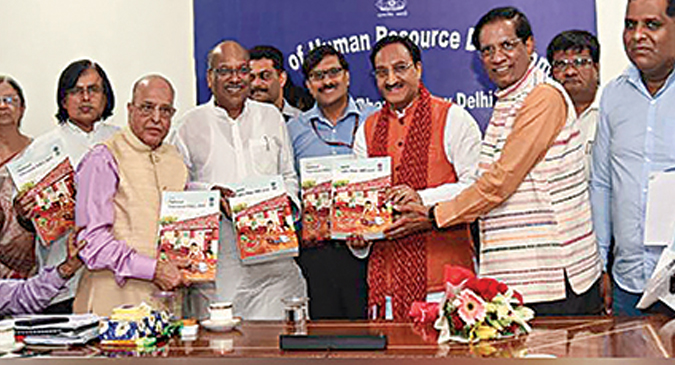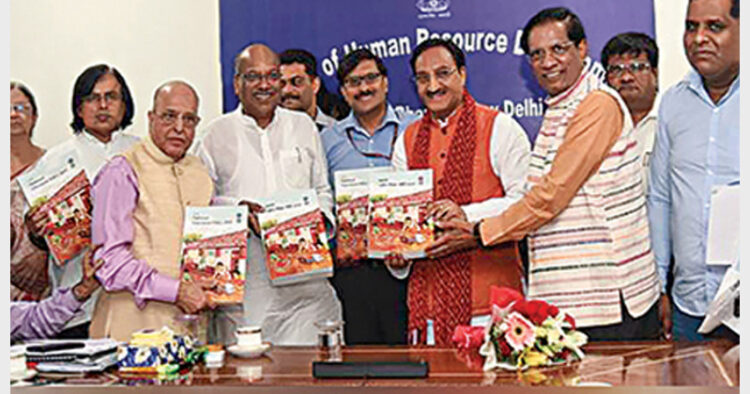In keeping with the changing times, Bharat truly needs a transformative educational system that will put the country on the path towards new dawn without leaving behind an outdated Western system of education in favour of a system of Gurukul
Dr Satish Kumar
The draft document on New Education Policy (NEP) has been dragged into the undesirable controversy. The North-south Divide Syndrome played up by sensational and biased media. It was a throwback to the 1960s when the politics of South was dictated through the Hate Hindi propaganda. Much water has flown since 1967; most of the people in the southern parts of India are acclimatised to the Hindi. The mindset was changed not by the government orders but by the popularity of Hindi movies and serials. A mix of Hindi with South Indian movies created a new generation which considers and adopt a new India. The current reactions are more political than social.

Dr K Kasturirangan and his team members presenting the draft National Education Policy to Union HRD Minister Ramesh Pokhariyal ‘Nishank’ and MoS Sanjay Shamrao Dhotre in New Delhi
There are a couple of real stories which are relevant to mention. A group of kids from class 7 to 9th standard visited their villages during winter seasons. They went out to the fields, where they were asked to identify the lush green crops in the field; none of them did it correctly. Why did it happen? If you try to go through the summer holidays homework of Public schools irrespective of regions and cities, you will find most of the homework spanned from knowing Germany to Chinese arts and culture. Education in India is more extraneous than intrinsic. An attempt has never been part of the policy to know more about ourselves and our identity.
Aping the West, Bharat graduated into India only to have a lopsided education system that is a means to an end—to lead a luxury lifestyle at the cost of the value systemThe second story is about indigenous knowledge of tribal women. In 2016, a few witch killing took place in a few villages on the outskirts of Ranchi. While conducting fieldwork on the same issue, we interacted with a 70-year-old tribal woman. It was a bright day at noon without any sign of rain. The woman cautioned us, “Get your work done in 15 minutes. Heavy rain is likely in 15 minutes”. We gaped at her and said, “how could you say that? There is no inch of cloud and you are talking about rain!” Exactly after 15 minutes, it started to rain heavily. Surprisingly, indigenous knowledge made us think twice about our stereotypical bookish knowledge. The tribal woman had gained her indigenous knowledge through the experience of cattle’s tail twisting and sounds. There are many such real stories of life.
Subsequently, a ‘Committee for Evolution of the New Education Policy’ under the Chairmanship of Late TSR Subramanian, Former Cabinet Secretary, was constituted, which submitted its report in May 2016. Based on this report, the ministry prepared ‘Some Inputs for the Draft National Education Policy, 2016’. An eminent scientist Kasturirangan headed the Draft committee submitted its proposal for debate and discussion which would give the final shape before endorsing a new education policy by the government.
While a sound education system creates values among pupils, ultimately becoming the fabric of social and political lives, the present education system in India is devoid of such characters. Aping the West, Bharat graduated into India only to have a lopsided education system that is a means to an end—to lead a luxury lifestyle at the cost of the value system which is already at a low ebb. And therefore, sports and music are considered antidote to education. The overall development of a child is not possible without a proper set of the sports system. One-third problems of the country are related to the physical weakness of the youth, Vivekanand had said. To address the issues, the Modi Government is leaving no stone unturned to refurbish the education system that empowers people through education. Under “Khelo India” scheme, the Government is trying to improve sports infrastructure in villages. Digital blackboard is one of the top priorities of the Government. And efforts are on to use the technology to enhance teachers’ skills as well—several other initiatives aimed at improving the overall condition of the education system. More than hundred new Kendriya Vidyalayas and 62 new Navodaya Vidalayas have been opened during the last four years. Ekalavya Model Residential schools will be opened in the tribal areas. Despite these praiseworthy initiatives, higher education is afflicted with many ills. The scheme of upgraded autonomy is bound to create further problems in the education system. “I am a Stephenian, a JNUite or an LSRite” will only widen the chasm. The existing apartheid system in the educational system will further deepen if the Government policies are not implemented in toto. The debate on the need for foreign faculty members is picking up, even as the concept of “Gurukul” has been pigeonholed as traditional. Rubbing salt into the wound is the exodus of brains from quality educational institutions in India to the US and the EU, for greener pastures. To address this burning issue, the Central Government is trying to reverse the brain drain into brain gain through the scheme of Prime Minister Schemes of Fellowships. Though it is not enough, well begun is half done. One of the fundamental aims of education is to identify core values. There is a need to connect children with Indian heritage along with the western tips.
Many new themes are being added. The first in the list is to empower the village communities on Gandhian thought. This draft has created an opportunity to create a campus connecting from Anganwadi to 12th Class in each bloc. This campus will be connected with a functional library, life learning laboratory and playground. The students would be learning not merely from books but practical skills too, which are required to develop and strengthen the village societies. The skills will generate job opportunities at the local level.
Creative and critical thinking are also embedded in the new education system. The concept of earlier scientific temper, which J Nehru was fond of calling it a ‘den of ignorance as it moved away from a traditional value system and religious beliefs, this definition of scientific temper does not fit into the Indian psyche. All traditional values are not regressive but progressive at many times. Because of the ignorance of our knowledge, none of our social scientists has contributed to evolving theories. We remained a copy cat, toed the line of western perspectives. This education policy will create space for indigenous knowledge mixing with the modern techniques and evolving a new chapter which would be called Indian perspectives of Social science.
The controversial Four Year Undergraduate Programme (FYUP), which was scrapped in 2014, may make a comeback as a panel constituted by the HRD Ministry has recommended the programme among undergraduate course reforms for the new National Education Policy.
The four-year programme will provide greater rigour and allow students to conduct research, optionally,” the draft said. “Students will graduate with a four-year Liberal Arts Science Education degree with Honours, or may graduate with a B Sc, BA, B Com or B Voc after completing three years with a suitable completion of credits within their subject,” it said.
The government has a clear roadmap. The Prime Minister is determined to evolve India’s lost position of ‘Vishwa Guru’ in the coming years. Yoga and Kumbh have started that process. Higher education will shape the roadmap. The University Grants Commission (UGC) is headed by a visionary academician, Prof D.P Singh, who knows the nuts and bolts of Indian higher education. Things will change in the coming years. The unnecessary controversy on the Hindi language is undesirable. The government has made it clear Hindi will not be imposed on any regional languages. The purpose is to connect all for making it more inclusive and indigenous. This Draft policy is just an attempt to narrow that gap between India and Bharat.
(The writer is Assistant Professor at MMH College, Ghaziabad)














Comments